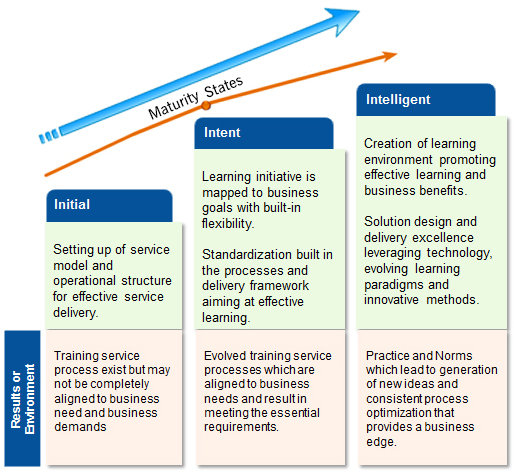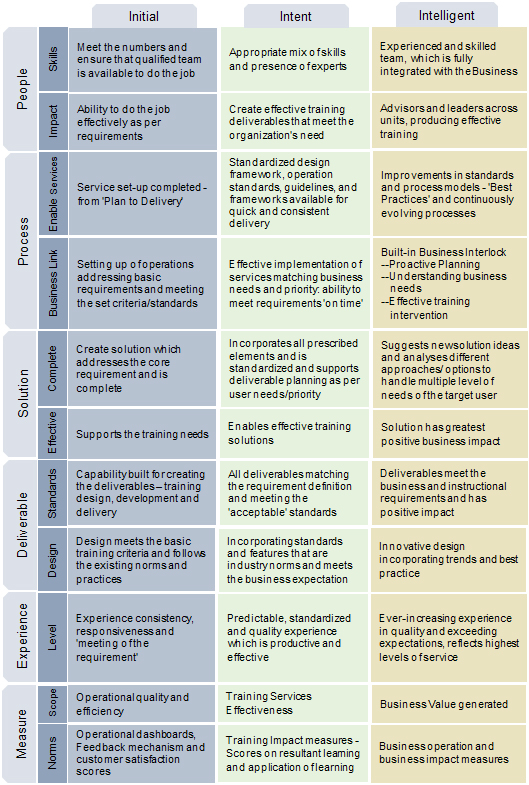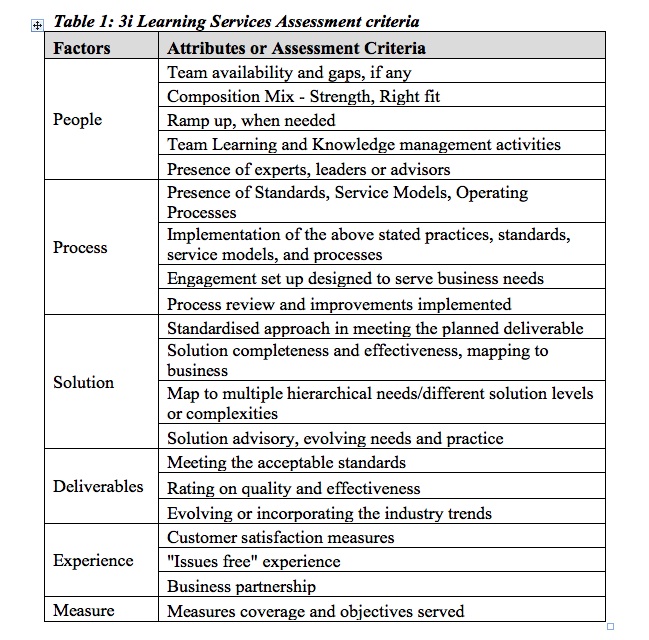
The Learning Services practice comprises multiple factors or parameters that determine the outcome and effectiveness of the learning and development activities it is responsible for. These factors or parameters are the building blocks for the services, as well as a reflection of the completeness and effectiveness of them.
It is possible to set up a benchmark or model for the analysis of the factors or parameters that build up a learning service practice/organization. This evaluation model leads to the creation of the learning services maturity model, which rates the maturity of the services being provided by a learning service organization. This model is useful for determining the quality and effectiveness of the learning and development activities that a learning service organization is responsible to deliver.
A Learning Services organization could be an internal unit of an enterprise, responsible and accountable for the learning and development activities within the organization. This also includes external service providers, who provide training services to an organization, including training solution design, training content design and development, training delivery, training program management, training infrastructure, and training administration.
An effective learning services maturity model must support an organization to continuously evolve and grow its learning services practice or enable the learning service organization’s (internal and external) progress on a maturity scale and, thus, provide the “best in class” learning intervention.
To set the benchmark for learning service maturity, three states (3i) of maturity can be identified: initial, intent, and intelligent
The 3i Learning Services Maturity Model describes these three different states of maturity, addresses its objective, and relates to the initiatives with the perceived business benefits of each state.
Figure 1: 3i Learning Services Maturity States

The 3i Learning Services Maturity Model focuses on six parameters that are the building blocks for the services, as well as the factors that reflect on service effectiveness. These are:
- People
- Process
- Solution
- Deliverables
- Experience
- Measure
A successful Learning Services practice would require close alignment with the business needs and aim at meeting the business requirements and expectations. Moreover, the Learning practice has to continuously evolve and change with the business dynamics, work practices, and advancements in technology. Through the maturity study, one attempts to analyze the alignment of the Learning Services practice with the business needs and goals; and measure the agility and adaptability of the Learning practice to reflect adaptation to best practices and trends.
Learning services maturity can be achieved systematically by addressing the six parameters of service effectiveness and maturity against the 3 stages of maturity (i.e., Initial, Intent, and Intelligent) as described in Figure 2.
Figure 2: 3i Learning Services Maturity Concept Model

This model enables organizations to evaluate the current learning services capability (of the internal or external services organization) and plan a journey toward achieving a higher (desired) state of maturity or capability. It enables organizations to evaluate the standards of learning and development activities being delivered by the services organization and identify the state of maturity, along with the potential or possible roadmap to reach higher stages of learning services effectiveness and maturity.
To assess the learning services practice and the maturity state, a well-defined framework is needed to measure the contributing factors (i.e., people, process, solution, deliverables, experience, and measure). The purpose of the maturity assessment is to offer a framework, which will facilitate:
- Identification of the current state of the Learning Services organization (external or internal) and its performance in terms of people, process, solution, deliverables, experience, and measure
- Identification and articulation of the current maturity level
- Definition of a suitable plan of action for improving the services practice
- Creation of a roadmap for reaching the next or desired level of maturity
Table 1 provides an overview of the key assessment factors, incorporated as part of the 3i Learning Services maturity model.

The learning services maturity assessment exercise starts with the collection of data and information on the above parameters/factors. These parameters are further analyzed to derive the ratings for each of the factors based on the scores generated from the assessment criteria or attributes. Each of these assessment criteria or attributes is assigned a relative weight, and the rating of the factors (i.e., people, process, solution, deliverables, experience, and measure) is a weighted average. Ultimately, the final maturity score of the learning service organization/practice is taken as the weighted average of all of the six contributing factors.
The assessment score and rating must follow the following conditions:
- Represents the facts
- Quantifies the attributes for the six factors
- Articulates and differentiates the states of maturity
- Graphically represents the measurable parameters for easy, distinguishable, and intuitive comparatives
The maturity score gives insight on current performance level, key strengths, and identified weak areas. The detailed report will provide the current level of performance in each of the factors/parameters as depicted by the individual scores. This gives enough data points to create a report on current performance level and desired performance level for each of the assessment criteria or attributes. Finally, this leads to identification of the key themes or action points for each of the factors that define the roadmap for improving the maturity level of the Learning Services practice.
The Learning Services organization must follow a continuous improvement or evolutionary path. The demands of knowledge workers, business dynamics, and the changing work culture and practices due to emerging technologies are leading to shifts in learning practices. All these factors make it crucial for a Learning Services organization to continuously evaluate and define a path for improvement or evolution. The 3i Learning Services Maturity Model supports this exercise of reviewing, evaluating, and improving the practices of a Learning Services organization in order to meet the demand for continuous improvement and excellence.
A. Amitabh S. Sinha is with Tata Consultancy Services Ltd. and is responsible for Enterprise Learning Services with a focus on designing and implementing learning solutions for various leading global companies. His core expertise includes learning consulting, strategy, solution design, development, implementation, and effectiveness measurement. For more information, e-mail him at: amitabh.sinha@tcs.com or contact him via LinkedIn at: https://in.linkedin.com/pub/amitabh-sinha-akhauri/24/268/731.




